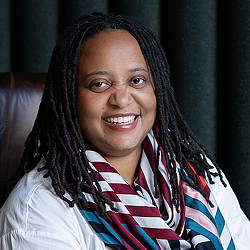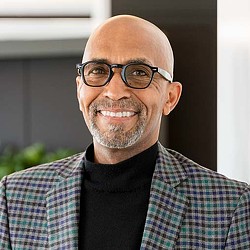How Architects and Designers Can Continue to Prioritize Inclusivity
December 16, 2021 | By Lisa Cholmondeley, Roger Smith
Editor’s Note: This blog is part of our Design Forecast blog series, looking at what’s next in 2022 and beyond. Here, we sit down with Roger Smith and Lisa Cholmondeley, co-directors of Gensler’s Center for Research on Equity and the Built Environment, to ask them about designing for diversity, equity, and inclusion, and what lies ahead:
We talk a lot about designing spaces for equity and inclusion and a lot of people aren’t quite sure what that means or looks like. What work is there still to do, and how do you define inclusive spaces?
Roger: Part of it is defining it for ourselves as an organization. I think that’s really important. It’s part of our principles to foster diversity. It’s built into our DNA.
We know that diversity leads to innovation. So, there seems to be a lot of momentum that we can build that’s already founded in our culture. I think that’s the starting point — and then in terms of space, that’s a bit more complicated.
It’s about our colleagues engaging and thinking about what the spatial implications are for communities that we build in. Also, our clients are starting to demand that we think in this way. So, we have to define it for ourselves, and we have to engage our clients to understand their approach. But there’s a lot of learning to do, and that’s what the Center for Research on Equity on the Built Environment is all about.
How are Black voices and people of color represented in the design process? Why is it important to engage the community to create equity or be more inclusive in these spaces?
Lisa: There are a number of teams funded by the Center that are looking at this question of community engagement in different ways — from co-creation to partnerships. The collective work is really powerful. These are important voices and we may have to try a few ways to connect and come together but it’s valuable to do it.
Roger: We’re serving our clients, and our clients are building buildings in communities, so why wouldn’t you engage the community in order to enrich the experience of that space in that community? It seems like a natural extension of our job.
I’m working on a couple projects right now, one is the Newark Community Museum for Social Justice. Community engagement was essential to the development of the museum. It actually started out as a studio that I taught at NJIT with students who learned how to engage communities as a part of their design process. Then Gensler was asked to extend beyond that studio and work on the project itself.
That community engagement was absolutely essential because it spoke to the aspirations of that community and was built into all the early-stage aspirational student work while also informing everything we did in developing that concept.
What role can Gensler, as the world’s largest architecture and design firm, play in leading the industry to make positive and lasting change?
Lisa: Our impact is huge in lots of ways. It is our scale. It is the clients. It is the kind of work we do.
I do think we have maintained a level of commitment that other firms have not. And I would hope that we'd encourage and remind other firms that they need to keep doing that. We have the Gensler Research Institute Center for Research on Equity on the Built Environment, we’ve given to HBCUs, we’ve just kept doubling down on this.
What can we expect next from Gensler’s Center for Research on Equity and the Built Environment?
Lisa: Right now, the Center is focused on Black Lives and Design but over time there will be different areas of focus. It’s a hugely powerful piece in our broad research platform to acknowledge the role that the built environment plays in equity and justice. We can acknowledge there are voices that we’ve not been paying attention to that have always been affected by what we do.
The Center asked students what they thought about different kinds of buildings. It’s a question we never asked before. Sure, we’ve asked, “How many square feet of schools do we build? What type of universities do we build?” But we never stopped and asked a population, “What does this mean to you?” or “What do these designs mean to you?” That’s huge.
Roger: In this case, the young people should be engaged with that process in an active way as a part of building the space. If they’re elementary school students, so be it. They should have a voice and we should understand their perceptions.
There’s no doubt that we have enormous impact and the key is just to continue leading regardless of whether others engage or create similar reports on diversity and inclusion. And that will propel us forward because everything is moving in this direction naturally, and everyone else will come along over time.
This is about the long-term commitment, and that’s going to be the key to success. Lisa and I both have been committed to continuing to learn as we design and to use that research to inform the spaces that we create at Gensler.
For media inquiries, email .


